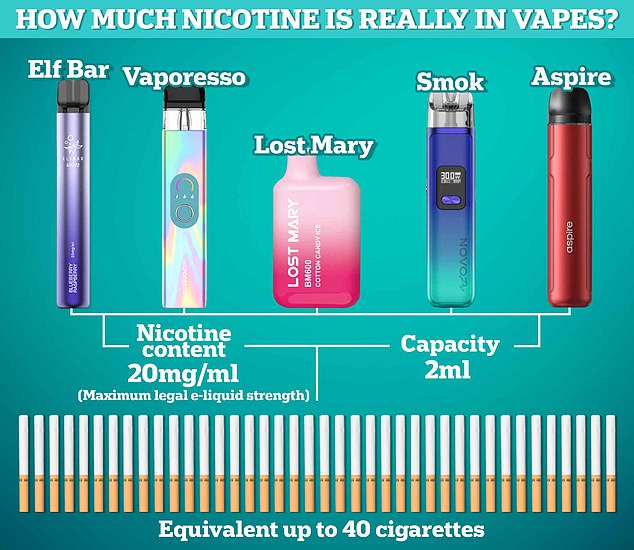Passive vaping: Children exposed to second-hand nicotine smoke from vapes, first-of-its-kind study proves… but risk is far lower than cigarettes
A study found that children exposed to secondhand vapor clouds have five times the amount of nicotine in their bodies as normal people.
However, youth exposed to e-cigarette vapor had 84 percent less of the addictive substance in their bodies compared to youth exposed to secondhand smoke from traditional cigarettes.
The British researchers who conducted the study said their findings, based on a cohort of nearly 1,800 US children, suggested that switching from traditional cigarettes to e-cigarettes could reduce children’s risk of exposure to second-hand smoke.
But they also warned that reduction is not the same as elimination and that vaping around children should be “avoided.”
In the study, researchers from the University of College London compared cotinine levels in blood samples from children from different US households, stratified by smoking and vaping status.
Youth exposed to e-cigarette vapor had 84 percent less of the addictive substance in their bodies compared to those exposed to traditional secondhand cigarette smoke (stock image)
Cotinine is a substance that the body produces itself when breaking down nicotine. Tests for cotinine are considered the gold standard for determining exposure to this addictive substance.
In total, researchers examined cotinine results in 1,777 children aged three to 11 years, collected between 2017 and 2020.
Of this group, 270 were exposed to cigarette smoke, 43 to e-cigarette vapor, and 1,464 to neither.
Children exposed to passive smoke reported the highest cotinine levels of 0.49 micrograms per liter.
For comparison, children of vapers ingested only 0.08 micrograms of cotinine per liter. This represents an 83.6 percent reduction in nicotine exposure compared to children exposed to passive smoking.
However, this was still 402 percent higher than the cotinine level measured in children who did not smoke or vape (0.016 micrograms per liter).
For comparison, a cotinine level of 15 micrograms per liter of blood indicates that a person has used a nicotine product, such as cigarettes or vapes.
Researchers who published their findings in the journal Jama Network Openaccording to the results It was suggested that children’s exposure to second-hand nicotine through e-cigarettes was much lower than that through cigarettes.
This is likely also true for other harmful chemicals emitted by traditional tobacco products, they added.
However, they warn against exposing children to e-cigarette vapor indoors.
‘However, vaping in the home around children should be avoided. Although nicotine itself has a limited risk profile, the increased absorption of nicotine from secondhand vapor suggests that children were also exposed to other potentially harmful substances from e-cigarettes,’ the researchers said.
However, independent researchers were more positive about the results, claiming they showed the amount of nicotine vapers exhale is “negligible.”
Professor Peter Hajek, an expert in health and lifestyle research at Queen Mary University of London, said: ‘The research confirms that, as expected, the amount of nicotine exhaled by vapers and exposed to children and other bystanders is negligible.
‘Passive vaping probably does not pose any health risks, but vapers should of course be aware that others may not like the smell or sight of the aerosol from their device.’
According to the researchers, a limitation of their study was that they divided children based on exposure to smoking or vaping in general. They did not account for differences in the frequency of smoking or vaping at home. More research was needed in this area.
Another limiting factor they highlighted was that the children’s parents, who were asked whether there was smoking in their household, may have lied out of fear of judgment, which could have influenced the results.
Vape use has exploded in recent years among both adults and children in the UK.
Research shows that the number of young adults using the devices has tripled in just two years, with the increase also being a more modest 6 percent among adults over 45.
Other figures show that the number of children using e-cigarettes has increased dramatically. More than a third of 16-18 year olds now regularly inhale e-cigarettes.
For comparison, ten years ago, less than one in ten did so.
This is despite the fact that the sale of e-cigarettes to under-18s is illegal, with anyone caught selling them to children risking a fine and prosecution by Trading Standards.
Campaigners have long blamed predatory manufacturers for the deepening crisis.
They claim that some brands are deliberately luring children in with colourful packaging, instead of highlighters, and with child-friendly flavours such as bubble gum and candy floss, all for ‘pocket money’ prices.
Rishi Sunak’s government has introduced a bill on tobacco and vaping, which includes measures to limit the availability of e-cigarettes to children and discourage non-smokers from taking up smoking.
This included a pledge to completely ban disposable e-cigarettes, which are popular with children, by 2025.
But the bill was killed by the general election, although charities have since called on Keir Starmer’s new government to reintroduce it.
E-cigarettes allow people to inhale nicotine in the form of vapor. This vapor is created by heating a liquid, which typically contains propylene glycol, glycerin, flavorings, and other chemicals.

Campaigners have long blamed predatory manufacturers for the growing crisis, claiming they deliberately lure children in with colourful packaging, rather than highlighters, and child-friendly flavours such as bubble gum and candy floss.
Unlike traditional cigarettes, they do not contain tobacco and do not produce tar or carbon – two of the most dangerous elements.
The effect of nicotine on the brain is well known: within 20 seconds of inhalation, it causes the release of chemical messengers such as dopamine, which are associated with reward and pleasure.
But it also increases heart rate and blood pressure and causes blood vessels to constrict. This is because nicotine triggers the release of the hormone adrenaline.
Experts largely agree that vaping is safer than smoking, but it’s not without risk. E-cigarettes contain harmful toxins, and their long-term effects remain a mystery.
Some specialists fear that the high nicotine content could raise blood pressure and cause other heart problems.
Doctors fear that in the coming decades there could be a wave of lung diseases, dental problems and even cancer in people who start smoking at a young age.

